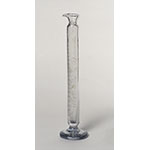The Berthollimeter (in French: berthollimètre) is an analytical-chemistry instrument named after the French chemist Claude-Louis Berthollet. Invented by François-Antoine-Henri Descroizilles in 1791, the original device served to measure the quantity of chlorine in dyes used in the dyeing art. Descroizilles built a new version in 1806. Closely resembling the original, it soon enjoyed commercial success. As it allowed the measurement of the quantity of alkaline substances in fluids, Descroizilles gave it the more explicit name of "alkalimeter" (alcalimètre). The specimen exhibited is composed of a graduated glass test tube with a beak, resting on a large flat base. One side bears the inscription "Bertholli-mètre," the other "Alcali-mètre de Descroizilles."









